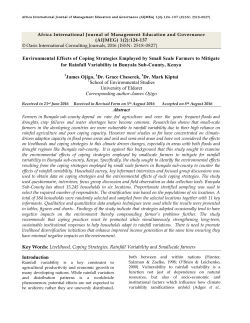
OUR WATER FUTURE - Department of Land Resource Management
OUR WATER FUTURE Discussion Paper: A Conversation with Territorians CASE STUDY 3 Planning for climatic variability and growth - remote communities in the arid zone Demonstration of Strategic Policy Priority 5: Ensure resilient water supplies and sanitation Remote water supply in the arid zone of the Northern Territory Indigenous Essential Services (IES), a subsidiary of Power and Water Corporation (PWC), provides potable water to 28 remote indigenous communities in the southern portion of the Northern Territory. With the exception of Yuelamu, all of these communities rely exclusively on water pumped from underground aquifers. In one third of these communities, the aquifers are of limited extent. Strategic planning to maintain safe and secure potable supplies into the future relies not only on an understanding of the local and regional water resources, but on determining potential changes in climate. Increased climate variability could both limit potable water availability and change water demand trends. Climate and water availability Much, if not all, of the southern portion of the Territory is classified as ‘Hot Desert’ in the Koppen Geiger land type classification scheme, which denotes low annual rainfall, high rainfall variability and high summer temperatures. Unlike the Top End, aquifers in the southern Territory do not receive seasonal recharge from rainfall. Whilst a few communities’ aquifers recharge via direct rainfall (diffuse recharge; eg Ali Curung), at least 11 communities rely on episodic recharge every decade or so, from a cyclonerelated rainfall for example. The return period of such recharge events is hard to predict, which makes water resource management more difficult. Episodic recharge occurs in aquifers that supply Wutunugurra, Engawala and Laramba. The dam that supplies Yuelamu certainly relies on episodic rainfall which is unreliable. In at least 3 communities, the aquifer is considered non-renewable; the aquifer was recharged by rain falling tens of thousands or hundreds of thousands of years ago, when the climate was less arid. Non-renewable aquifer systems include the supplies for Yuendumu and Imanpa. Per capita water demand in these communities is not excessive; PWC data shows that communities supplied from more marginal water sources have a lower water demand, indicating that these communities are already conscious of limited resources. Climatic variability projections Climate models indicate that Northern Australia is very likely to warm, with a median 3.0°C expected by 2099 over the region north of 30°S. An increase in potential evaporation is considered likely, with a corresponding increase in moisture deficit (Christensen et al. 2007). Changes in rainfall in Northern and Central Australia are uncertain. Much, if not all, of the Barkly and Alice Springs regions are classified as ‘Hot Desert’ in the Koppen Geiger land type classification scheme. Climate change models predict that the land area classified as ‘Hot Desert’ will increase by 2050. This increase is attributed to a predicted increase in temperature (Barron et al. 2011). Impact on water availability and demand Increased potential evaporation will impact surface water sources such as Yuelamu dam, reducing the duration of available storage. A predicted decrease in diffuse recharge in central Australia (Barron et al. 2011) will lead to reduced aquifer storage in areas such as Ali Curung. Uncertainty in rainfall changes mean that changes to water availability in nearly half of the communities cannot be predicted. This is a risk. The Northern Territory Government population projections predict that indigenous population in the Barkly and Alice Springs regions (covering all of Southern NT) will increase by 1% and 1.4% per annum to 2026 respectively. Commensurate increases in water demand are manageable in all communities but those with marginal water sources. It is not known what additional increase the predicted temperature rise will have on water demand. Adapting to climatic variability and increased water demand Greater demand will increase the risk of source failure in some communities. Together, reduced water availability and increasing demand will increase competition for water among urban, irrigated agricultural, mining, industrial and environmental users. Whilst there are few competitors for water resources near most remote communities, this could change in the future. The resulting impacts on supply and demand depend on the adaptation responses available to users, many of which are influenced by water policy settings. Water demand management is a key tool for adapting to a warmer environment, and is one that IES already uses in water scarce areas, or in communities where the cost to serve is high. Diversifying away from marginal, recharge dependent groundwater sources to other, less climate-sensitive water sources such as recycled water is a possibility. Separate potable/non-potable systems in communities may become more technically and economically feasible in the future, and will preserve potable water sources in marginal areas. For further information: http://www.thesustainabilitycouncil.org/resources/ the-koppen-climate-classification-system/ https://www.powerwater.com.au/sustainability_and_ environment/remote_sustainability_initiatives/water_ resource_management References: Barron, O.V., Crosbie, R.S., Charles, S.P., Dawes, W.R., Ali, R., Evans, W.R., Cresswell, R., Pollock, D., Hodgson, G., Currie, D., Mpelasoka., F., Pickett, T., Aryal, S., Donn, M., and B. Wurcker. Climate change impact on groundwater resources in Australia. 2011. National Water Commission, ACT. http://archive.nwc.gov.au/__data/assets/pdf_file/0009/19872/Climate-change-impact-on-groundwater-resources-in-Australia.pdf Christensen, J.H., B. Hewitson, A. Busuioc, A. Chen, X. Gao, I. Held, R. Jones, R.K. Kolli, W.-T. Kwon, R. Laprise, V. Magaña Rueda, L. Mearns, C.G. Menéndez, J. Räisänen, A. Rinke, A. Sarr and P. Whetton, 2007: Regional Climate Projections. In: Climate Change 2007:The Physical Science Basis. Contribution of Working Group I to the Fourth Assessment Report of the Intergovernmental Panel on Climate Change [Solomon, S., D. Qin, M. Manning, Z. Chen, M. Marquis, K.B. Averyt, M. Tignor and H.L. Miller (eds.)]. Cambridge University, Cambridge, United Kingdom and New York, NY, USA. https://www.ipcc-wg1.unibe.ch/publications/wg1-ar4/ar4-wg1-chapter11.pdf For more information contact: Water Resources Division P: 08 8999 4455 | E : ourwaterfuture@nt.gov.au www.nt.gov.au/water
© Copyright 2025




















